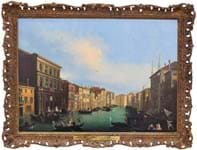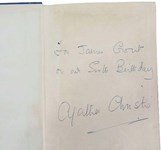
Douglas Bader, one of the signed portraits that formed part of the Pilots of Fighter Command lot sold by Dominic Winter for £1700.
Alongside bladed weapons, firearms, medals, models, paintings and photographs, a separate section offered all sorts of relics and wreckage from the Tonbridge Battle of Britain Museum collections.
From the main sale a books highlight landed in the form of a rather special copy of the 1942 first edition of Pilots of Fighter Command, a book by Captain Cuthbert Orde (1888-1968), who had served as a pilot during the First World War but later found success as an artist and illustrator.
A number of the many portraits by Orde it contains have over the years acquired signatures, among them the three reproduced here.
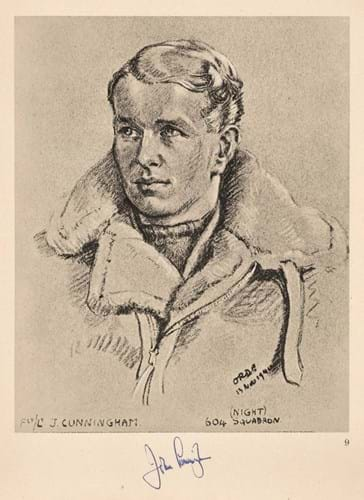
‘Cat’s Eyes’ Cunningham, one of the signed portraits that formed part of the Pilots of Fighter Command lot sold by Dominic Winter for £1700.
Those depicted in the accompanying illustrations are Flt Lt ‘Cat’s Eyes’ Cunningham, the RAF’s most successful nightfighter pilot, Sgt ‘Ginger’ Lacey, the second-highest scoring RAF pilot during the Battle of Britain period, and a man whose name will probably be more familiar, even to those without a special interest in the period: Squadron Leader Douglas Bader.
When acquired by an earlier previous owner, in May 1943, the book had borne only three signatures on the portraits. The others were mostly added while he was working at the RAF Museum in Hendon.
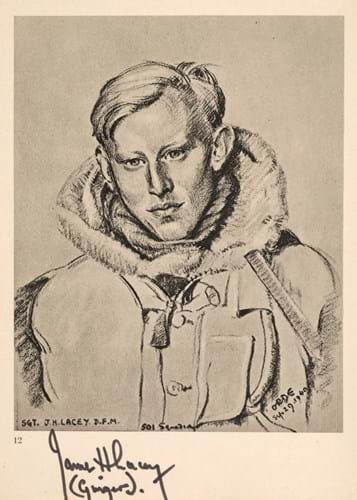
‘Ginger’ Lacey, one of the signed portraits that formed part of the Pilots of Fighter Command lot sold by Dominic Winter for £1700.
A great many other signatures were to be found on the front endpapers of the book, as well as in two accompanying folders, among them those of eight German nightfighter pilots.
On the day this extraordinary collection sold at £1700 against a guide of £1000-1500.
Byron learns his lines
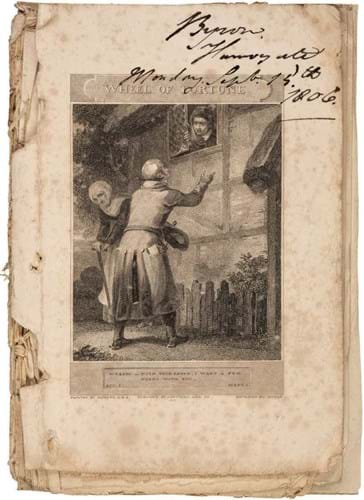
Bearing a note in his hand on the frontispiece, Byron’s personal acting copy of The Wheel of Fortune, a comedy in which, in 1806, he appeared as very young man, was sold at £7000 by Dominic Winter.
The highlight of the auction held a day earlier in South Cerney was the Elizabethan cheese-making manuscript that made a remarkable £45,000 (see our pick of the week in ATG No 2595).
Other stand-out lots of that sale included Lord Byron’s personal acting copy of the comedy The Wheel of Fortune, as performed at the Theatre Royal in London’s Drury Lane in 1806.
Condition was not this lot’s strong point, as the illustration of the stapled binding reveals, but this was the copy of the play by Richard Cumberland that was used by Lord Byron to learn his lines as Penruddock for a performance given in Harrogate in September 1806, when he was just 18 years old. It realised £7000.
Though very battered and lacking the final text leaf, it was billed as a unique and powerfully emotive association item from Byron’s tempestuous teenage years.

The pair of saucy postcards sent by Princess Diana to Constantine II of Greece that made £7000 at Dominic Winter.
A more unusual item from this Dominic Winter sale, again sold at £7000, was a pair of risqué greetings cards with artwork after Mike Edwards, in the spirit of particularly rude Donald McGill saucy seaside postcards.
They were signed and warmly inscribed by Diana, Princess of Wales around 1987 to “Dearest Tino” or Constantine II, the former and indeed last king of Greece, who died in January this year.
A close friend and second cousin of the future King Charles III, and godfather to his son, Prince William, Constantine and his wife Anne- Marie had made their home in London.
Sensitive readers should probably look away now…
One card read ‘What’s the definition of the Perfect Man?’ with the printed response found inside ‘A midget with a 10in tongue who can breathe through his ears!’.
On the other card reading ‘Adam came first…’ the response was ‘Men always do!’


